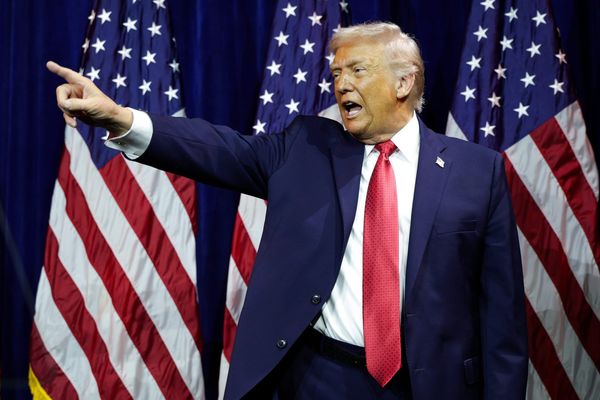
The common joke among Target (TGT) shoppers is that you always buy way more than you intended. Walk into a Target to buy fabric softener and unexpectedly leave with an entire summer wardrobe and a living-room set.
You might even forget to buy the fabric softener.
Over the years the company’s marketing team certainly has encouraged this mindset with slogans like “surprising and delighting our guests” or “expect the unexpected.”
But while Target has excelled at the unexpected, the company has long struggled to stock items that consumers actually expect from a large general-merchandise chain, like bread and milk.
CEO Invests in Solving a Consumer Pain Point
Shoppers might love to find that trendy Missoni or Kate Spade top. But they have also been frustrated at half-filled or empty shelves in the food and grocery aisles.
Under Chief Executive Brian Cornell, Target has invested heavily in solving that consumer pain point.
He's been remaking its inventory system so the chain is equally adept at selling high-frequency nondiscretionary items -- food and groceries -- as it historically has been with discretionary merchandise, like apparel and home furnishings.
The company has been making progress. Over the past three years, Target said comparable-store sales in food-and-beverage categories have enjoyed double-digit percentage increases.
“They have done a much better job,” said Burt Flickinger, managing director of consulting firm Strategic Resources Group in New York.
But Cornell’s efforts have taken on a greater urgency. With inflation at historic highs and worries of a recession abounding, consumers have cut back on clothes and home goods, Target’s traditional bread-and-butter categories.
Therefore, Target must adjust its inventory mix to reflect this economic reality, Cornell said on the fourth-quarter-earnings call.
“We're planning our business cautiously in the near term to ensure we remain agile and responsive to the current operating environment,” he said.
“We're pleased that we entered the year in a very healthy inventory position, reflecting our conservative approach in discretionary categories and our commitment to reliability in our frequency businesses.”
In a larger sense, Cornell is not just overhauling Target’s supply-chain systems and merchandise assortments. He’s reshaping the company’s core identity.
Target's Achilles Heel: Perishable Items
Target’s penchant for apparel is no accident. The Dayton family, which founded Target in 1961, made its fortune running department stores, which were once the pinnacle of the U.S. fashion scene.
Over the ensuing decades, Target helped pioneer the cheap-chic movement, offering consumers trendy apparel, accessories, and home goods at discount prices. (Remember Tar-ZHAY?)
The company grew adept at creating buzz and excitement: It forged partnerships with estimable designers like Italian fashion house Missoni as well as Jason Wu, Lilly Pulitzer, and Michael Graves to create time-limited, exclusive merchandise for its stores.
But starting in the 1990s, Target’s effort to add groceries has been riddled with supply hiccups. Perishable, fast-turning items like milk and fresh meat are infinitely harder to manage versus hoodies and skirts, which don’t have expiration dates.
“Target’s inventory management system has held them back on consumables,” Flickinger said. “It has been their Achilles heel.”
Target has relied on third-party wholesalers to supply its stores instead of building out its own distribution system. But Target and those wholesalers have not always worked well together, Flickinger said.
The company’s grocery struggles also rested in its overall business model.
Unlike rivals like Walmart (WMT) which aggressively sought sales growth, Target has traditionally placed greater value on preserving its profit margins.
As a result, the company preferred leaner inventories. The last thing Target wanted to do was to slash prices on piles of unsold merchandise the way Gap (GPS) and JCPenney (JCP) often heavily discount their unsold clothes and accessories.
Such rampant price reductions undercut Target’s reputation as a higher end, classier mass retail chain. That’s why you almost never see signs screaming 50%-70% clearance, “Everything Must Go!” sales at a Target.
Target applied the same lean inventory approach to groceries, which combined with its wholesaler issues frequently led to shortages of key products.
In 2013, Target’s inventory snafus led to perhaps its most greatest failure: its aborted attempt to expand into Canada.
Target’s foray into Canada was the first time the company tried to enter a foreign market. And from the start, consumers complained through social media that the stores frequently ran out of bread, eggs, and milk.
In many ways, the debacle wasn't surprising, Flickinger said. Target had contracted Sobeys, one of Canada's largest supermarket chains and food wholesalers, to supply its stores.
But Sobeys directly competed with Target on groceries. Hence, the flaw with Target’s reliance on third-party wholesalers, Flickinger said. Sobeys’s first priority is to keep its own stores well stocked versus easing its competitors’ supply woes, he said.
Rebalancing the Target Portfolio
When Cornell joined Target as CEO in 2014, one of his first big decisions was to close all 155 stores in Canada and absorb more than $5 billion in losses from discontinued operations.
That Target’s board hired Cornell showed how much things needed to change.
He was the first outside person to become CEO in the company’s history. Normally, Target recruited its CEOs from within its ranks, longtime employees whom the company spent years grooming for senior leadership positions.
Prior to Target, Cornell held top leadership positions at Safeway (ACI) and Walmart's (WMT) Sam’s Club — all major food retailers.
Cornell has often spoken about the need to balance the product portfolio between discretionary and nondiscretionary merchandise, best represented in the retailer’s ubiquitous “Expect More, Pay Less” motto.
“It’s about balance,” he once said. “It’s…that unique item that we only sell like the ($35) Victoria Beckham dress.”
“But we also need to make sure we deliver great value on household essentials, because those drive the trip,” Cornell said. “It’s both the things you need and things you want.”
To that end, Cornell has focused on applying the same merchandising skills that made Target's apparel and accessories business so successful to food and beverages, most notably the aggressive use of private labels.
In addition to Archer Farms and Market Pantry, the retailer sells exclusive brands of adult beverages, including California Roots and Mystic Reef. In 2022, store and exclusive brands generated more than $30 billion, about a third of the company’s overall revenue of $108 billion.
Cornell’s strategy seems even more relevant today, given the country’s topsy-turvy economic outlook.
After buying a lot of stuff online to entertain and comfort themselves during the lockdown pandemic years of 2020 and 2021, consumers have significantly cut back discretionary purchases because of inflation, Flickinger said.
In addition to “balance,” Cornell’s favorite words of late have been “agile” and “flexibility.”
Transformative, and Subtle, Efforts
And for good reason. Last spring, faced with soaring prices and weak consumer demand, the company said it would significantly reduce its inventory, especially discretionary categories like apparel and home goods, by discounting and canceling orders.
It was a remarkable announcement for a number of reasons. First, Target’s actions were decisive and unusually transparent, two traits somewhat alien to the company’s historically deliberate, insular culture.
Secondly, Cornell did what the company normally hates to do: get rid of inventory by cutting prices. As a result, Target’s prized profit margins took a big hit — at least for the short term.
Flickinger calls Cornell’s decisions “transformative moves. From Columbus Day to New Year, Target did a good job liquidating inventory.”
The company ultimately accomplished a tricky balancing act. Last year, the company grew comparable-store sales at a relatively solid 2.2%, reduced inventory of discretionary merchandise by 13%, and positioned operating-profit margins to hit 6 percent by early 2024.
Through decisions both subtle and bold, Cornell has been remaking Target into a more effective general merchandise retailer beyond its department store roots.







